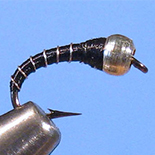10 Must-Have Chattahoochee Flies
In truth, there are dozens of flies that could be used on the Chattahoochee River, especially below the Buford Dam. There are also more than a dozen opinions on which flies work best and in which conditions. However, from careful research and gathered experience we present to you – in no particular order! – the flies successful Chattahoochee anglers won’t leave home without.
1 | Y2K
 Sizes 16, 18 | tying video
Sizes 16, 18 | tying video
The Y2K is a bead-head egg pattern made with two contrasting colors of yarn that is trimmed into a conical shape. It’s generally tied in orange/pink or orange/yellow. It’s a simple pattern to tie and, as it somewhat imitates a subsurface bouncing trout egg, triggers the trout quite effectively. Purists may shy away from this one, but they can’t deny its effectiveness!
2 | San Juan Worm or Squirmy Wormy
 Sizes 12, 14, 16 | tying video
Sizes 12, 14, 16 | tying video
There are aquatic worms in many rivers and fish are not shy about eating them. There are purists who say this is worm fishing. Fact is, the San Juan Worm fly imitates a worm just like a Muddler imitates a sculpin. These can be tied in a number of ways and colors: with chenille (as pictured), with rubber materials, lead wrapped, etc.
3 | Zebra Midge
 Sizes 16, 18, 20, 22 | tying video
Sizes 16, 18, 20, 22 | tying video
The zebra midge is a great subsurface fly pattern where chironomids are present. Chironomids can represent a significant portion of the trout’s diet. These are quite simple to tie if you can only decide upon which variation! While black is the general favorite, these work great in yellow, red, brown, etc.
4 | Pheasant Tail Nymph
 Sizes 14, 18 | tying video
Sizes 14, 18 | tying video
The Pheasant Tail imitates so many species. It’s a very buggy looking nymph that can imitate mayflies, small stones, and even damsels. Some tie these with bead-heads, flashback, and all sorts of little add-ons. However you tie it, it’s a versatile nymph to have in the box when prospecting for trout.
5 | Hare’s Ear Nymph
 Sizes 12, 14, 16, 18, 20 | tying video
Sizes 12, 14, 16, 18, 20 | tying video
Perhaps the most recognized, fished, and proven nymph ever tied. The hare’s ear nymph will attract fish even when there is no hatch on. It’s a nymph whose “bugginess” entices fish into striking. It can be tied in a variety of ways: bead-head, flashback, wire ribbing, etc. However you tie it, it’s a proven must for every fly box.
6 | Wooly Bugger
 Sizes 6, 8, 10, 12 | tying video
Sizes 6, 8, 10, 12 | tying video
This is an excellent fly for swinging down current. The fish-like movement of a pulsating wooly bugger is sure to draw strikes from big trout just as the fly reaches the end of the swing and begins to move upstream. Lead wraps and bead heads can help get this pattern down quickly to the feeding area. It’s usually tied with chenille, hackle, and marabou of various colors.
7 | Parachute Adams
 Sizes 16, 18, 20, 22 | tying video
Sizes 16, 18, 20, 22 | tying video
This is a versatile dry fly and has become recognized as a popular pattern on trout rivers around the world. It’s a good pattern to use after the mayflies have been hatching for awhile and there is no immediate hatch happening. The “parachute” in the name comes from the light colored post on top of the fly that helps the angler see the small fly on the water.
8 | Black Ant
 Sizes 14, 16, 18, 20 | tying video
Sizes 14, 16, 18, 20 | tying video
In all types of fisheries, fish dine on ants and other terrestrials as they fall into the water. It may seem like an overly simple pattern and, perhaps, a bit lackluster, but the black ant is a must-have fly seeing as so much of a trout’s diet is made up of them. But just don’t stick with black! Try in dark brown, cinnamon, or some crazy UV colors as well. Some even tie the body with foam.
9 | Elk Hair Caddis
 Sizes 16, 18, 20 | tying video
Sizes 16, 18, 20 | tying video
This is classic pattern that represents many different stages of adult caddis, a fluttering caddis hopping along to drink water, or a cripple whose wings never really developed upon hatching. When the bugs are hopping everywhere, it’s a great pattern to skate and twitch. It also makes a deadly indicator to fish droppers below. Tie in tan in spring and orange in fall.
10 | Soft Hackle Wet Fly
 Sizes 14, 16, 18, 20 | tying video
Sizes 14, 16, 18, 20 | tying video
Soft hackle wet flies are amazing in their productivity. The theory is that the wet hackle pulsates as it moves through the water, inducing strikes. Every successful angler has a box or a section of their box dedicated to soft hackles in all their staggeringly beautiful variations. For a new soft hackle strategy, tie up some simple Tenkara-type flies with the hackle facing “backward”.
